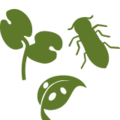(Oomycota: Oomycetes Class Saprolegniales: genus Pythium)
[Pythium, damping-off]
Life cycle
Pythium aphanidermatum belongs to the class Oomycetes and is related to Phytophthora species. Oomcytes produce oospores, which are sexual spores that serve as resting bodies and a form of survival in unfavourable conditions. Oospores are thick-walled and are therefore resistant to extreme temperatures and dehydration. Oospores can survive in the soil for a long time (years). Oospores may germinate directly or produce sporangia. Sporangia may germinate directly as well, but they can also produce swarm spores. These swarm spores (zoospores) can swim in water and are attracted to germinated seed or young roots by the exudate they secrete. Zoospores germinate and infect seedlings, often at the soil line or in the seed or roots. If conditions are not favourable for infections, zoospores can encyst and thus survive in the soil for a long period of time, provided the moisture content remains adequate. On the plant, the zoospores germinate with long plant-infecting hyphae that bore through the epidermis. The fungus can form new sporangia within a matter of days. Exudates secreted by the fungus kill the plant cells, which causes rotting. The fungus affects seeds and seedlings alike, both before and after emergence. This fungus is very widespread and can survive in soil as a saprophyte. Only seeds and young seedlings are severely affected; older plants can be infected, but will not die from the resulting disease.
Host plants
P. aphanidermatum has a wide range of host plants, including cucumber, pot plants, cereals, Brassica species and beans. In the Netherlands, it is particularly prevalent in cucumber.
Symptoms
Early infection causes loss of seedlings. Newly germinated seedlings become constricted, turning brown near the soil surface, and collapse. Infection post-emergence causes yellowing leaves, drooping leaves and total wilting. Brown lesions appear on the stems and watery, dark decay appears on the roots. The epidermis can easily be scraped away. Lateral roots and tops rot, and sometimes the entire root system rots away.
Conditions
P. aphanidermatum is especially problematic in environments with high water content in soil or substrate and at high temperatures (summary in Martin & loper, 1999). The disease occurs primarily at soil or substrate temperatures of between 32 and 37 °C (Compendium of Cucurbit Diseases, 1996).
Cultivation measures
- good drainage, substrate not too wet, do not give too much water;
- do not sow or plant in high temperatures;
- clean base materials;
- in greenhouses: avoid high temperatures by chalking or using roof sprinklers;
- disinfect recirculation water;
- in cucumber: adjust height and type of substrate e.g. perlite rather than rock wool or higher rock wool mats;
- using resistant strains or resistant rootstock.










